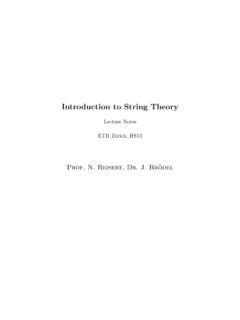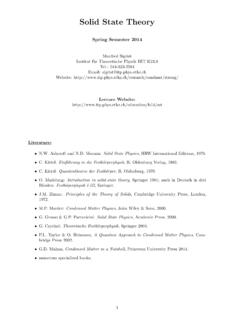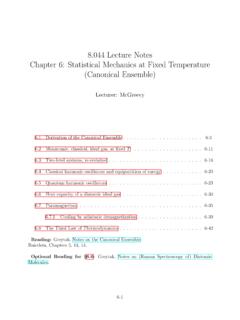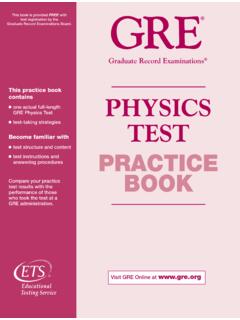Transcription of Solid State Theory
1 Solid State TheorySpring Semester 2014 Manfred SigristInstitut f ur Theoretische Physik HIT : 044-633-2584 Email: Website: : Ashcroft and Mermin: Solid State Physics, HRW International Editions, 1976. C. Kittel:Einf uhrung in die Festk orperphysik, R. Oldenburg Verlag, 1983. C. Kittel:Quantentheorie der Festk orper, R. Oldenburg, 1970. O. Madelung:Introduction to Solid - State Theory , Springer 1981; auch in Deutsch in dreiB anden:Festk operphysik I-III, Springer. Ziman:Principles of the Theory of Solids, Cambridge University Press, London,1972.
2 Marder:Condensed Matter Physics, John Wiley & Sons, 2000. G. Grosso & Parravicini: Solid State Physics, Academic Press, 2000. G. Czychol:Theoretische Festk orperphysik, Springer 2004. Taylor & O. Heinonen,A quantum Approach to Condensed Matter Physics, Cam-bridge Press 2002. Mahan,Condensed Matter in a Nutshell, Princeton University Press 2011. numerous specialized Electrons in the periodic crystal - band Symmetries of crystals .. groups of crystals .. lattice .. Bloch s theorem and Bloch functions .. Nearly free electron approximation.
3 Tight-binding approximation .. combination of atomic orbitals - LCAO .. structure of s-orbitals .. structure of p-orbitals .. functions .. binding model in second quantization formulation .. Symmetry properties of the band structure .. Band-filling and materials properties .. count and band filling .. , semiconductors and insulators .. Semi-classical description .. of motion .. oscillations .. densities .. Appendix: Approximative band structure calcuations .. plane wave ..332 The band structure in group IV .. and band structure.
4 Elementary excitations .. excitations .. properties .. Doping semiconductors .. State .. concentration .. Semiconductor devices ..4923 The Jellium model .. of metals - Sommerfeld and Pauli .. of metals - a Hartree-Fock approach .. Charge excitations .. response and Lindhard function .. excitation .. excitation - Plasmon .. Phonons .. of a isotropic continuous medium .. in metals .. instability in one dimension .. of phonons and the dielectric function ..744 Itinerant electrons in a magnetic The de Haas-van Alphen effect.
5 Levels .. behavior of the magnetization .. equation .. quantum Hall Effect .. effect of the two-dimensional electron gas .. quantum Hall Effect .. quantum Hall Effect ..895 Landau s Theory of Fermi Lifetime of quasiparticles .. Phenomenological Theory of Fermi Liquids .. heat .. susceptibility .. invariance .. of the Fermi liquid .. Microscopic considerations .. parameters .. function .. liquid in one dimension? .. 1096 Transport properties of Electrical conductivity .. Transport equations and relaxation time.
6 Boltzmann equation .. Drude form .. relaxation time .. Impurity scattering .. scattering .. effect .. Electron-phonon interaction .. Electron-electron scattering .. Matthiessen s rule and the Ioffe-Regel limit .. General transport coefficients .. Boltzmann equation .. effect .. Anderson localization .. Formula for a single impurity .. at two impurities .. localization .. 1367 Magnetism in Stoner instability .. model within the mean field approximation .. criterion.
7 Susceptibility forT > TC.. General spin susceptibility and magnetic instabilities .. dynamic spin susceptibility .. with finite wave vectorQ.. of the band structure .. Stoner excitations .. 1508 Magnetism of localized Mott transition .. model .. State .. metallic State .. liquid properties of the metallic State .. The Mott insulator as a quantum spin system .. effective Hamiltonian .. field approximation of the anti-ferromagnet .. Collective modes spin wave excitations .. 1634 IntroductionSolid State physics (or condensed matter physics) is one of the most active and versatile branchesof modern physics that have developed in the wake of the discovery of quantum mechanics.
8 Itdeals with problems concerning the properties of materials and, more generally, systems withmany degrees of freedom, ranging from fundamental questions to technological applications. Thisrichness of topics has turned Solid State physics into the largest subfield of physics; furthermore,it has arguably contributed most to technological development in industrialized 1: Atom cores and the surrounding matter ( Solid bodies) consists of atomic nuclei (ions), usually arranged in a regular(elastic) lattice, and of electrons (see Figure 1). As the macroscopic behavior of a Solid isdetermined by the dynamics of these constituents, the description of the system requires the useof quantum mechanics.
9 Thus, we introduce the Hamiltonian describing nuclei and electrons, H= He+ Hn+ Hn e,(1)with He= i p2i2m+12 i6=i e2|ri ri |, Hn= j P2j2Mj+12 j6=j ZjZj e2|Rj Rj |,(2) Hn e= i,jZje2|ri Rj|,where He( Hn) describes the dynamics of the electrons (nuclei) and their mutual interaction and Hn eincludes the interaction between ions and electrons. The parameters appearing aremfree electron 10 31kgeelementary 10 19 AsMjmass ofj-th nucleus 103 104 mZjatomic (charge) number ofj-th nucleusThe characteristic scales known from atomic and molecular systems are5 Length: Bohr radiusaB=~2/me2 10 10mEnergy: Hartreee2/aB=me4/~2=mc2 2 27eV = 2 Rywith the fine structure constant =e2/~c= 1/137.
10 The energy scale of one Hartree is muchless than the (relativistic) rest mass of an electron ( ), which in turn is considered smallin particle physics. In fact, in high-energy physics even physics at the Planck scale is considered,at least theoretically. The Planck scale is an energy scale so large that even gravity is thoughtto be affected by quantum effects, asEPlanck=c2 ~cG 1019 GeV, lPlanck= ~Gc3 10 35m,(3)whereG= 10 11m3kg 1s 2is the gravitational constant. This is the realm of the GUT(grand unified Theory ) and string Theory . The goal is not to provide a better description ofelectrons or atomic cores, but to find the most fundamental Theory of theory10 meV10 eV1 MeVelectrons, coresatomphenomenologicalstandard modelGUTM-theoryhigh-energy physicsastrophysics and cosmologysolid State physicsknown and establishedeffectivemodelstheorymost physicsFigure 2.





